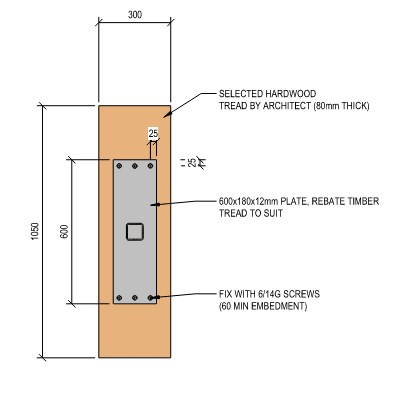Just looking for a reality check/opinions on this. I'm designing a mono stair stringer for a client (pdf attached showing the layout and section). The stair has 2 short runs with landings and one longer run. The client would like to keep the monostringer as thin as possible. I'm suggesting an HSS8x2x1/2. I've modeled this in Risa 3D with 40psf off center, or a 300 lb point load at the edge of the tread. I'm keeping the deflection limited to 1/4" at the end of the tread. The reactions are fairly reasonable since the short stringer runs at the top and bottom can spread out the torsion into a T/C couple.
I've checked vibration per the AISC design guide and making the vertical and horizontal periods work is not a problem. The stair has handrails the start horizontally coming out from the wall and go under the treads and turn up, so it is pinned to the wall for horizontal stability at 4'oc. I am at about 1.98%g for the eq 4-8 in the design guide. I think with the added stiffness of the welded angles, handrails, etc I should be able to get this under the recommended 1.7%.
I have 2 questions:
1) Intuitively an 8x2 makes me a little worried that it's going to feel bouncy when someone stands off-center however with the analysis that I have done I am getting more comfortable with it. Does this seem like a crazy idea to anyone else?
2) I've seen some people posting about checking vibration using dynamic analysis in Risa 3D. What loads do you use for the dynamic analysis? is it the 168# point load in the AISC design guide? or just the stair weight? When I run the dynamic analysis using the point load I don't get any mode shapes with participation over 25 but it does seem like it's giving me some possibly useful information on the frequency. The model won't run with just the dead load.
I've checked vibration per the AISC design guide and making the vertical and horizontal periods work is not a problem. The stair has handrails the start horizontally coming out from the wall and go under the treads and turn up, so it is pinned to the wall for horizontal stability at 4'oc. I am at about 1.98%g for the eq 4-8 in the design guide. I think with the added stiffness of the welded angles, handrails, etc I should be able to get this under the recommended 1.7%.
I have 2 questions:
1) Intuitively an 8x2 makes me a little worried that it's going to feel bouncy when someone stands off-center however with the analysis that I have done I am getting more comfortable with it. Does this seem like a crazy idea to anyone else?
2) I've seen some people posting about checking vibration using dynamic analysis in Risa 3D. What loads do you use for the dynamic analysis? is it the 168# point load in the AISC design guide? or just the stair weight? When I run the dynamic analysis using the point load I don't get any mode shapes with participation over 25 but it does seem like it's giving me some possibly useful information on the frequency. The model won't run with just the dead load.


